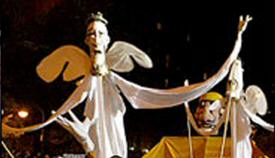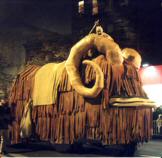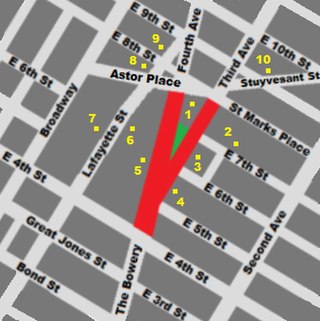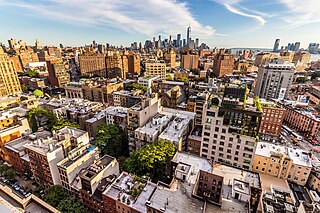
Greenwich Village, or simply The Village, is a neighborhood on the west side of Lower Manhattan in New York City, bounded by 14th Street to the north, Broadway to the east, Houston Street to the south, and the Hudson River to the west. Greenwich Village also contains several subsections, including the West Village west of Seventh Avenue and the Meatpacking District in the northwest corner of Greenwich Village.

Manhattan is the most densely populated and geographically smallest of the five boroughs of New York City. The borough is coextensive with New York County of the U.S. state of New York, the smallest county by land area in the contiguous United States. Located mostly on Manhattan Island near the southern tip of the State of New York, Manhattan constitutes the geographical and demographic center of the Northeast megalopolis and the urban core of the New York metropolitan area, the largest metropolitan area in the world by urban landmass. Manhattan serves as New York City's economic and administrative center and has been described as the cultural, financial, media, and entertainment capital of the world.
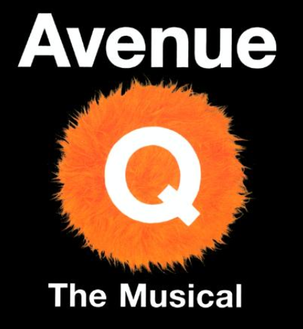
Avenue Q is a musical comedy featuring puppets and human actors with music and lyrics by Robert Lopez and Jeff Marx and book by Jeff Whitty. It won Best Musical, Book, and Score at the 2004 Tony Awards. The show's format is a parody of PBS's Sesame Street, but its content involves adult-oriented themes. It has been praised for its approach to themes of racism, homosexuality and internet pornography.

Sixth Avenue – also known as Avenue of the Americas, although this name is seldom used by New Yorkers – is a major thoroughfare in New York City's borough of Manhattan, on which traffic runs northbound, or "uptown". It is commercial for much of its length.
John Nicholas Tartaglia is an American actor, singer, and puppeteer.

Jeanne Fleming is an American Celebration Artist from New York City, who organized the Harbor Festival Fair in 1986, the Official Land Celebration for the Centennial of the Statue of Liberty and who is currently director of New York's Village Halloween Parade.
Ralph Lee was an American puppeteer and theatre artist. His work was centered on the design and use of masks in theatre and performance. The majority of his productions took place outside of traditional performance venues, included parades, pageants, celebrations, and outdoor theatrical performances. Masks and large puppets were central to his productions, which aimed to make artistic experiences accessible to all members of the community. He staged his productions in familiar, public locations, charging no admission fee whenever possible and creating vivid images that could immediately resonate with the audience.

Sophia Michahelles is one of the two chief artists and puppeteers of Processional Arts Workshop, makers of pageant puppets and other processional art in upstate New York. She works closely with co-director Alex Kahn. The couple's work, under the informal moniker "Superior Concept Monsters" has been commissioned each year since 1998 to lead New York's Village Halloween Parade, the largest puppet parade and street-pageant of its kind in the United States, drawing two million spectators.
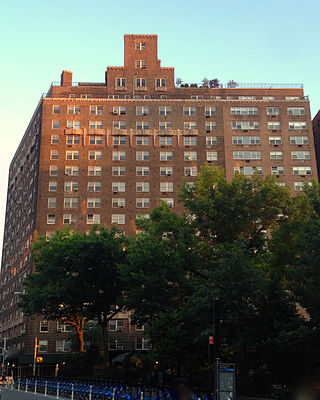
The West Village is a neighborhood in the western section of the larger Greenwich Village neighborhood of Lower Manhattan, New York City. The West Village is bounded by the Hudson River to the west and 14th Street to the north. The eastern boundary is variously cited as Greenwich Avenue, Seventh Avenue, or Sixth Avenue, while the southern boundary is either Houston Street or Christopher Street.

The NYC Pride March is an annual event celebrating the LGBTQ community in New York City. The largest pride parade in North America and among the largest pride events in the world, the NYC Pride March attracts tens of thousands of participants and millions of sidewalk spectators each June. The parade route through Lower Manhattan traverses south on Fifth Avenue, through Greenwich Village, passing the Stonewall National Monument, site of the June 1969 riots that launched the modern movement for LGBTQ+ rights.
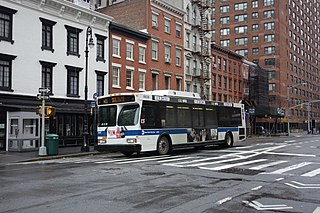
The Ninth and Tenth Avenues Line or Ninth Avenue Line is a surface transit line in the New York City borough of Manhattan, running mostly along Ninth Avenue and Amsterdam Avenue from Lower Manhattan to Manhattanville. Originally a streetcar line operated by the Manhattan and Bronx Surface Transit Operating Authority, it is now the M11 bus route operated by the New York City Transit Authority.
Alex Kahn is an American visual/performance artist and co-founder of the arts ensemble Processional Arts Workshop. He is most widely known for his creation of the large-scale puppet performance works that lead New York's Village Halloween Parade each year.

Village Preservation is a non-profit organization which advocates for the preservation of architecture and culture in several neighborhoods of Lower Manhattan, New York. Since it began in 1980, it has engaged in efforts to attain landmark status for a variety of sites like the Stonewall Inn and Webster Hall. The organization and its Executive Director, Andrew Berman, have been described as influential in New York real estate, while some of its activities to prevent development and to support restrictive zoning have attracted criticism.
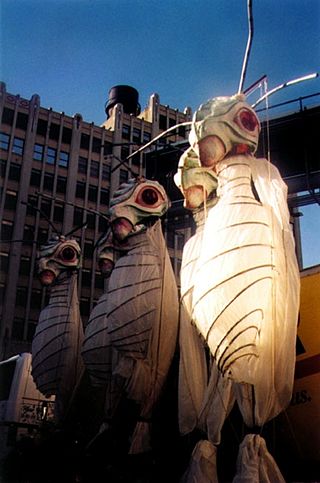
Processional Arts Workshop (PAW) is an ensemble of performing artists and theatrical technicians founded in 1998, devoted to pageant puppetry and processional art. They are also known by the name Superior Concept Monsters (SCM). They are best known for creating the large-scale puppet performances that lead New York's Village Halloween Parade.

New York City has been described as the gay capital of the world and the central node of the LGBTQ+ sociopolitical ecosystem, and is home to one of the world's largest LGBTQ populations and the most prominent. Brian Silverman, the author of Frommer's New York City from $90 a Day, wrote the city has "one of the world's largest, loudest, and most powerful LGBT communities", and "Gay and lesbian culture is as much a part of New York's basic identity as yellow cabs, high-rise buildings, and Broadway theatre". LGBT travel guide Queer in the World states, "The fabulosity of Gay New York is unrivaled on Earth, and queer culture seeps into every corner of its five boroughs". LGBT advocate and entertainer Madonna stated metaphorically, "Anyways, not only is New York City the best place in the world because of the queer people here. Let me tell you something, if you can make it here, then you must be queer."

Father Demo Square is a 0.25-acre (0.10-hectare) triangular park and piazza bounded by Sixth Avenue, Bleecker Street, and Carmine Street in the South Village neighborhood of Lower Manhattan, New York City. The park is named for Father Antonio Demo, who was the pastor of the neighboring Our Lady of Pompeii Church from 1897 to 1935. The church was relocated to Carmine Street in 1926–1928 to accommodate an extension of Sixth Avenue south of Bleecker Street, which created the triangular plot of land. The park, located opposite Carmine Street from the church, was established in 1923 with the Sixth Avenue extension and the land was improved as a park, being named in a tribute to Demo.
Stonewall 50 – WorldPride NYC 2019 was a series of LGBTQ events and celebrations in June 2019, marking the 50th anniversary of the 1969 Stonewall riots. It was also the first time WorldPride was held in the United States. Held primarily in the metropolitan New York City area, the theme for the celebrations and educational events was "Millions of moments of Pride." The celebration was the largest LGBTQ event in history, with an official estimate of five million attending Pride weekend in Manhattan alone, including an estimated four million in attendance at the parade. The twelve-hour parade included 150,000 pre-registered participants among 695 groups.

A giant puppet is a puppet which is tall enough to be easily visible to a street crowd while being manipulated by puppeteers, on the same level. It is therefore most suitable for processions, street theatre and performance art, although some large theatrical animations can be used for the same purpose. Giant puppets are usually articulated and made from a lightweight material. Some are manipulated by puppeteers using rods, strings, stilts, other mechanisms, or a combination of these. Giant puppets have been used worldwide for street entertainment, celebrations or other purposes from ancient times, and they continue in use and in development today. Of the traditional giant rod puppets, the Chinese dragon New Year puppet is "perhaps the most recognized form of the parade puppet". Of the most recent examples, Royal de Luxe of France has produced a notable set of giant string puppets.

